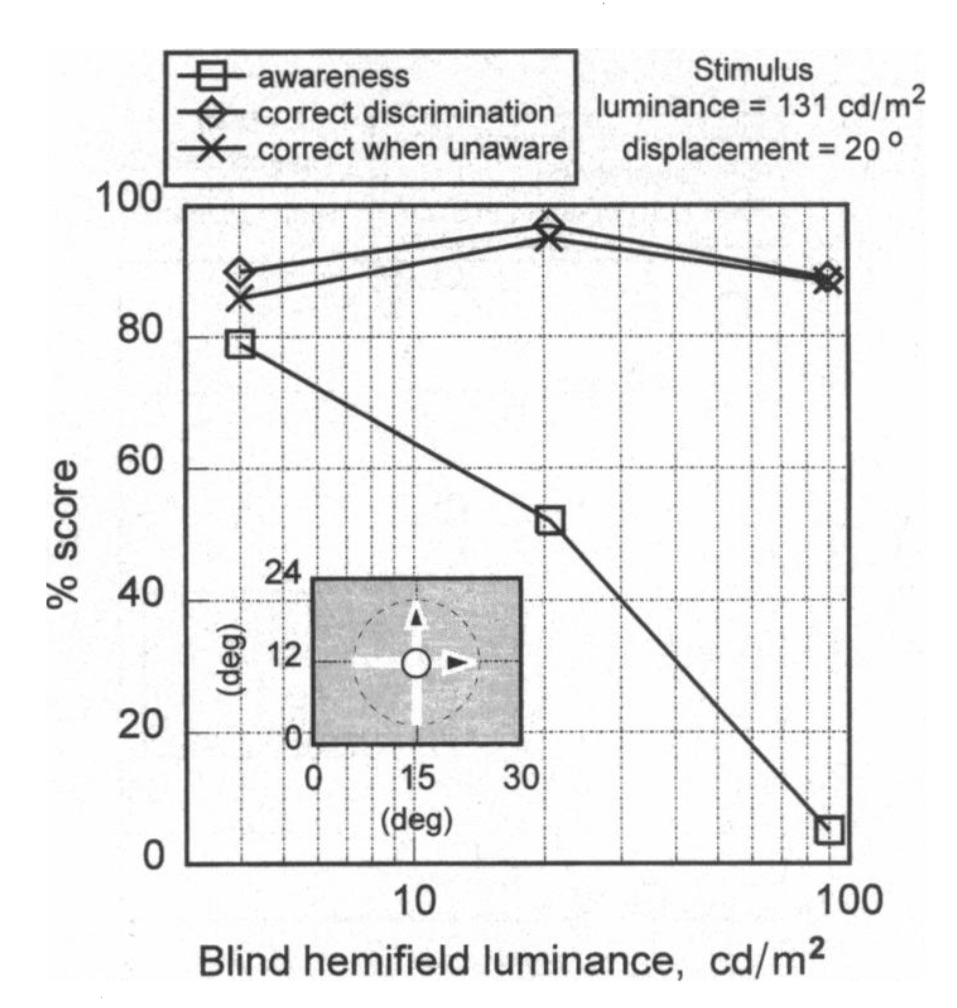Click here and press the right key for the next slide (or swipe left)
(This may not work on mobile or ipad. You can try using chrome or firefox, but even that may fail. Sorry.)
(If the slides don’t work, you can still use any direct links to recordings.)
also ...
Press the left key to go backwards (or swipe right)
Press n to toggle whether notes are shown (or add '?notes' to the url before the #)
Press m or double tap to slide thumbnails (menu)
Press ? at any time to show the keyboard shortcuts
Lecture 07:
Mind & Reality
\def \ititle {Lecture 07}
\def \isubtitle {Mind & Reality}
\begin{center}
{\Large
\textbf{\ititle}: \isubtitle
}
\iemail %
\end{center}
Previous lecture:
What are the functions of perceptual awareness?
This lecture:
Can you perceive something without being perceptually aware of it?
\section{Dretske, Master of Distinctions}
\emph{Reading:} §Dretske, F. (2006). Perception without awareness. In Gendler, T. S. and Hawthorne, J. O., editors, Perceptual Experience, pages 147–180. OUP, Oxford.

Anyone know who this is?
Dretske, master of distinctions
Perception without Awareness
Type 1 : You perceive it but are unaware of some fact about it
Type 2 : You perceive an object but are unaware of it.
‘Perception without awareness, unconscious perception, is [...] to be understood as perception of some object without awareness (conscious) of that object.’
Two names for the same thing (see Dretske footnote 2)! Sloppy.
/ex/TorF/qq/Our question concerns the possibility of perceiving an object while being unaware of some fact about it|Our question concerns the possibility of perceiving an object while being unaware of it
/ex/TorF/qq/We are following Dretske in using the words ‘consciousness’ and ‘awareness’ interchangeably

Perception without Awareness?
\section{Perception without Awareness?}
\emph{Reading:} §Weiskrantz, L., Barbur, J. L., and Sahraie, A. (1995). Parameters affecting conscious versus unconscious visual discrimination with damage to the visual cortex (V1). Proceedings of the National Academy of Sciences, 92(13):6122–6126., §Sidis, B. (1898). The psychology of suggestion. Appleton, New York.
Can you perceive something without being perceptually aware of it?
Yes : Sidis
Yes : blindsight

Sidis’ subjects are not perceptually aware of the letter but can identify and report it.
k k k k
Can you perceive something without being perceptually aware of it?
Yes : Sidis
Yes : blindsight
Weiskrantz et al, figure 2
Awareness makes no measurable difference to action.
Can you perceive something without being perceptually aware of it?
Yes : Sidis
Yes : blindsight
Are we convinced by this evidence?
\section{A Test for Perception?}
\emph{Reading:} §Dretske, F. (2006). Perception without awareness. In Gendler, T. S. and Hawthorne, J. O., editors, Perceptual Experience, pages 147–180. OUP, Oxford.

‘If psychologists can really identify something that deserves to be called perception without awareness, they must have an operational grasp on not only what it takes to perceive something, but on what it takes to be conscious of it.
\citep[p.~148]{Dretske:2006fv}
Dretske, 2006 p. 148
We need to start by clarifying what we mean by perceiving.
We have been clarifying what we mean by perceiving in terms of simple seeing.
But can we go further and give a ‘test for perception’?
blindsight:
infer perception from discrimination of visual stimuli
This was the point of talking about simple seeing.
You must have got information about the thing
But: allergic reactions to ragweed
What does it take to perceive something?
By what test could we measure whether someone has perceived a particular object?
According to Dretske, to perceive an object:
\begin{itemize}
\item you must have got information about the thing; and
\item ‘the information [...] should be available for the control
and guidance of action’; and
\item ‘the information should
be extracted from stimulation [...] by
accredited receptor systems’ \citep[p.~150]{Dretske:2006fv}.
\end{itemize}
Note Dretske’s qualification:
‘Even with the additional qualifications [not specified here],
this ‘test’ for perception of an object is not going to withstand philosophical
scrutiny---too many loose ends and philosophically troublesome qualifiers’
\citep[p.~151]{Dretske:2006fv}.
and ‘the information in these states should be available for the control
and guidance of action’
and ‘the information should
be extracted from stimulation [...] by
accredited receptor systems.’
Dretske, 2006 p. 150

Operationalising Visual Awareness (I)
\section{Operationalising Visual Awareness (I)}
\emph{Reading:} §Dretske, F. (2006). Perception without awareness. In Gendler, T. S. and Hawthorne, J. O., editors, Perceptual Experience, pages 147–180. OUP, Oxford., §Sidis, B. (1898). The psychology of suggestion. Appleton, New York.
‘If psychologists can really identify something that deserves to be called perception without awareness, they must have an operational grasp on not only what it takes to perceive something, but on what it takes to be conscious of it.
\citep[p.~148]{Dretske:2006fv}
Dretske, 2006 p. 148
blindsight:
infer perception from discrimination of visual stimuli
we infer lack of awareness from the subject’s reports
Task 1 : Say when you can see which letter it is.
Task 2 : Guess the letter (forced choice).
Task 1 vs Task 2 : example of biased vs unbiased response
Group 1: £10 if you answer correctly, -£1 wrongly
Group 2: £1 if you answer correctly, -£10 wrongly
shifting criteria.
A point made by \citet{cowey:2010_blindsighta} and Phillips
‘If psychologists can really identify something that deserves to be called perception without awareness, they must have an operational grasp on not only what it takes to perceive something, but on what it takes to be conscious of it.
\citep[p.~148]{Dretske:2006fv}
Dretske, 2006 p. 148
blindsight:
infer perception from discrimination of visual stimuli
we infer lack of awareness from the subject’s reports
Can you perceive something without being perceptually aware of it?
Yes : Sidis
Yes : blindsight???
considerations just raised imply we should not consider Sidis as
entirely compelling evidence.
What about blindsight? Should we consider this in the same way?
/ex/TorF/qq/A forced-choice task is an example of a biased task|A signal detection task (Say when you detect it!) is an example of a biased task
/ex/TorF/qq/A forced-choice task is an example of an unbiased task|A signal detection task (Say when you detect it!) is an example of an unbiased task
/ex/TorF/qq/Comparing performance on a biased task with performance on an unbiased task is completely fine and could not conceivably create any problems|Sidis (1898) has shown that you can perceive things without being aware of them

Operationalising Visual Awareness (II)
\section{Operationalising Visual Awareness (II)}
\emph{Reading:} §Phillips, I. B. and Block, N. (2017). Debate on unconscious perception. In Nanay, B., editor, Current Controversies in Philosophy of Perception, chapter 11, pages 163–192. Routledge, London., §Phillips, I. B. (2016). Consciousness and Criterion: On Block’s Case for Unconscious Seeing. Philosophy and Phenomenological Research, 93(2):419–451.
Can you perceive something without being perceptually aware of it?
Yes : Sidis
Yes : blindsight???
considerations just raised imply we should not consider Sidis as
entirely compelling evidence.
What about blindsight? Should we consider this in the same way?
According to Phillips we should ...
‘the claim that blindsight involves unconscious perception is largely based
on a dissociation between responding in a biased task and performance
in an unbiased forced-choice task’
Phillips, 2016 p. 435
\citep[p.~435]{phillips:2016_consciousness}
Let me recap the experiement briefly ...
Weiskrantz et al, figure 2
Awareness makes no measurable difference to action.
This conclusion is not entirely safe because we are relying on the subject’s reports.
‘the claim that blindsight involves unconscious perception is largely based
on a dissociation between responding in a biased task and performance
in an unbiased forced-choice task’
Phillips, 2016 p. 435
\citep[p.~435]{phillips:2016_consciousness}
Never trust a philosopher!
Can we therefore conclude that blindsight does provide evidence of perception without awareness?
‘It
is important to consider the possibility that blindsight in fact involves
abnormal and degraded, but nonetheless conscious, vision (Phillips 2016).’
Phillips, 2017 p. 5
Can you perceive something without being perceptually aware of it?
Yes : Sidis
Yes : blindsight???
Status : unresolved whether blindsight is evidence for perception without awareness at this point.
‘If psychologists can really identify something that deserves to be called perception without awareness, they must have an operational grasp on not only what it takes to perceive something, but on what it takes to be conscious of it.
\citep[p.~148]{Dretske:2006fv}
Dretske, 2006 p. 148
blindsight:
infer perception from discrimination of visual stimuli
we infer lack of awareness from the subject’s reports
But our current concern is to find a test for perceptual awareness.
The problem is that if we rely on verbal reports, we will never get anywhere.
(Imagine a doctor relying on verbal reports to diagnose an illness.)
Can we make progress here?

Dretske’s Beautiful Theory
\section{Dretske’s Beautiful Theory}
\emph{Reading:} §Dretske, F. (2006). Perception without awareness. In Gendler, T. S. and Hawthorne, J. O., editors, Perceptual Experience, pages 147–180. OUP, Oxford., §Timmermans, B. and Cleeremans, A. (2015). How can we measure awareness? An overview of current methods. In Behavioral Methods in Consciousness Research, pages 21–46. Elsever, Amsterdam.
‘If psychologists can really identify something that deserves to be called perception without awareness, they must have an operational grasp on not only what it takes to perceive something, but on what it takes to be conscious of it.’
\citep[p.~148]{Dretske:2006fv}
Dretske, 2006 p. 148
blindsight:
infer perception from discrimination of visual stimuli
we infer lack of awareness from the subject’s reports
But our current concern is to find a test for perceptual awareness.
The problem is that if we rely on verbal reports, we will never get anywhere.
(Imagine a doctor relying on verbal reports to diagnose an illness.)
Can we make progress here?
‘objective criteria’
‘According to ‘objective’ criteria, unaware perception
occurs when a subject’s performance in a forced-choice task is at chance’
\citep[p.~190]{pessoa:2005_what}
Pessoa et al, 2005 p. 190
I.e. any discrimination is evidence for perceptual awareness.
Is this a good criterion?
Criticism of objective criterion
The objective criterion isn't s criterion for awareness, it is a criterion
for discrimination. We should only accept it if we this there's no
discrimination without awareness.
More on the objective criterion: if there is perception it may trigger
action or shift. In attention or some further processing, and awareness of
this could be used to discriminate. So intentional, explicit discrimination
tasks are of course tests of awareness of some.kind : but they are not
tests of *perceptual* awareness.
Support for this criticism of objective measures: 'they presuppose, unlike
subjective methods, that awareness of some information and (behavioral)
sensitivity to that same information involve the very same processes'
\citep[p.~22]{timmermans:2015_how}
'Above-chance performance on a forced-choice task involving the masked
stimulus need not necessarily be due to conscious knowledge'
\citep[p.~27]{timmermans:2015_how}
Timmermans & Cleeremans, 2015 p. 27
'The challenge of measuring awareness based on behavioral measures, despite
the substantial progress achieved over the years, remains essentially
intact'
\citep[p.~40]{timmermans:2015_how}
Timmermans & Cleeremans, 2015 p. 40
awareness : Dretske’s proposal
‘rTa: S is aware of X = S perceives X, and information about X is available
to S as a reason (justification) for doing what she wants (chooses,
decides) to do’
‘If psychologists can really identify something that deserves to be called perception without awareness, they must have an operational grasp on not only what it takes to perceive something, but on what it takes to be conscious of it.
\citep[p.~148]{Dretske:2006fv}
Dretske, 2006 p. 148
blindsight:
infer perception from discrimination of visual stimuli
we infer lack of awareness from the subject’s reports
we infer lack of awareness from information not being available to the subject as a reason for action








To see how this works, imagine you’re in a lab and the experimenter asks you to point at the light when it comes on. You’re told that if you don’t see the light, you should just guess. Only one light is supposed to come on, but the equipment is faulty and two lights come on in different places. Suppose that you see only the faulty light, although the experimenter wants you to point at the other one. If your finger ends up pointing at the faulty light, there is a sense in which you failed the test because you pointed at the wrong light. But there is a more basic sense in which your action succeeded, because you pointed at the light you saw. This would have been different if you hadn’t seen the light and just tried to guess where it was. In this case, the light you have to point at in order to succeed is the light the experimenter wants you to point at. This is how conscious perception makes a difference to what you do: it fixes what counts as success for your action.
Dretske’s Beautiful Theory
Can there be perception without awareness?
We infer perception from
information about the thing being in the subject
... and available for the control and guidance of action
... and being extracted from stimulation [...] by
‘accredited receptor systems’
We infer lack of awareness from
information not being available to the subject as a reason for action
What are the functions of perceptual awareness?
Perceptual awareness enables you to act for reasons.
(NOT: Perceptual awareness enables you to act.)
How perceptual awareness is actually operationalised in Weiskrantz et al, 1995:
we infer lack of awareness from the subject’s reports
How perceptual awareness should be operationalised according to Dretske, 2006:
we infer lack of awareness from information not being available to the subject as a reason for action
/ex/TorF/qq/According to ‘objective criteria’, unaware perception occurs when a subject’s performance in a forced-choice task is at chance|The claim that above-chance performance on any perceptual discrimination task must be due to perceptual awareness assumes that there is no perception without awareness|The problem at the end of this section concerns a discrepancy between Dretske’s operationalisation of perceptual awareness and Weiskrantz et al’s operationalisation.
/ex/TorF/qq/In Dretske’s 2006 article, his operationalisation of perception appears on page 148|In Dretske’s 2006 article, his operationalisation of perception appears on page 150|In Dretske’s 2006 article, his operationalisation of perception appears on page 152|In Dretske’s 2006 article, his operationalisation of perceptual awareness appears on page 171|In Dretske’s 2006 article, his operationalisation of perceptual awareness appears on page 172|In Dretske’s 2006 article, his operationalisation of perceptual awareness appears on page 174
\section{Conclusion on Awareness}

conclusion
In conclusion, ...
we have been asking two questions ...
What are the functions of perceptual awareness?
Wrong? : Perceptual awareness enables control of action.
Right? : Perceptual awareness enables you to act for reasons.
Can you perceive something without being perceptually aware of it?
Depending on operationalisation ...
blindsight provides evidence that you can.

A Process Dissociation Approach to Perception without Awareness
\section{A Process Dissociation Approach to Perception without Awareness}
\emph{Reading:} §Debner, J. A. and Jacoby, L. L. (1994). Unconscious perception: Attention, awareness, and control. Journal of Experimental Psychology. Learning, Memory, and Cognition, 20(2):304– 317., §Sandberg, K., Del Pin, S. H., Bibby, B. M., and Overgaard, M. (2014). Evidence of weak conscious experiences in the exclusion task. Frontiers in Psychology, 5.
Future addition:
also use Persaud, Navindra, and Alan Cowey. ‘Blindsight Is Unlike Normal Conscious Vision: Evidence from an Exclusion Task’. Consciousness and Cognition 17, no. 3 (1 September 2008): 1050–55. https://doi.org/10.1016/j.concog.2007.10.002.
David B
It feels like it is almost impossible to isolate perception without
having some conscious interference and thus it seems like it is hard to truly create
a perfect experiment without basically having unconscious participants
Recall this problem ...
How perceptual awareness is actually operationalised in Weiskrantz et al, 1995:
we infer lack of awareness from the subject’s reports
How perceptual awareness should be operationalised according to Dretske, 2006:
we infer lack of awareness from information not being available to the subject as a reason for action
\citep{debner:1994_unconscious}; see \citet{sandberg:2014_evidence} for criticism.
Theoretical point: we shouldn’t expect conscious and nonconscious processes to dissociate cleanly,
every effect can be influenced by both.
Debner & Jacoby, 1994
\citep{debner:1994_unconscious}
Stem : tab
Completions : table / taboo
Inclusion task : if you see ‘table’ , use this as the completion for ‘tab’
Exclusion task : if you see ‘table’ , DO NOT use this as the completion for ‘tab’
\citep{debner:1994_unconscious}
| task | effect of perceptual awareness on performance | effect of nonconscious perception on performance |
| Inclusion (use the word to complete the stem) | facilitates | facilitates |
| Exclusion | facilitates | impairs |
Task fits Dretske’s idea perfectly ...
How perceptual awareness should be operationalised according to Dretske, 2006:
we infer lack of awareness from information not being available to the subject as a reason for action
dividing attention : 23 table 37
‘The procedure that we used to divide attention was similar to a procedure used by Wolford and Morrison (1980). Flashed words were flanked by a pair of numbers, and, in the divided- attention condition, subjects were required to add those numbers.’
Key finding: dividing attention impairs perceptual awareness without affecting nonconscious perception
Conclusion: there is perception without awareness
Objection from Sandberg et al, 2014
perceptual awareness scale (PAS)
The response options were: “1: No experience” (NE), “2: Weak glimpse” (WG),
“3: An almost clear experience” (ACE), and “4: A clear experience” (CE).
\citep{sandberg:2014_evidence}
‘we found that failure to exclude a primed word from report was observed
almost to the same extent when participants reported that they had “no
experience” of the prime (PAS1) as when they had “a vague experience” or
perceived “a weak glimpse” (PAS2)’
On this objection ...
\citep{sandberg:2014_evidence} essentially say that people can report some
detection using the perceptual awareness scale (PAS).
Theoretically, they are rejecting Dretske’s crition.
The PAS scale
The response options were: “1: No experience” (NE), “2: Weak glimpse” (WG),
“3: An almost clear experience” (ACE), and “4: A clear experience” (CE).
\citep{sandberg:2014_evidence}
‘participants were instructed that NE should be used when there is no
experience at all, not even a faint sensation. WG should be used when there
is a very weak/vague visual experience without any ability to specify what
was perceived. ACE should be is used when there is an experience of what
was perceived, yet unclear or blurry. CE should be used when there is a
clear experience of what is perceived.’
\citep{sandberg:2014_evidence}
‘we found that failure to exclude a primed word from report was observed
almost to the same extent when participants reported that they had “no
experience” of the prime (PAS1) as when they had “a vague experience” or
perceived “a weak glimpse” (PAS2), but not when they had “an almost clear
experience” (PAS3) or “a clear experience” (PAS4).’
On Dretske’s criterion,
this criticism looks wrong.
That ‘there
is a very weak/vague visual experience without any ability to specify what
was perceived’
does not show there was perceptual awareness of the stimulus.
dividing attention : 23 table 37
‘The procedure that we used to divide attention was similar to a procedure used by Wolford and Morrison (1980). Flashed words were flanked by a pair of numbers, and, in the divided- attention condition, subjects were required to add those numbers.’
Key finding: dividing attention impairs perceptual awareness without affecting nonconscious perception
Conclusion: there is perception without awareness
Recall this problem ...
How perceptual awareness is actually operationalised in Weiskrantz et al, 1995:
we infer lack of awareness from the subject’s reports
How perceptual awareness is actually operationalised in Debner & Jacoby, 1994:
see Dretske!
How perceptual awareness should be operationalised according to Dretske, 2006:
we infer lack of awareness from information not being available to the subject as a reason for action




















